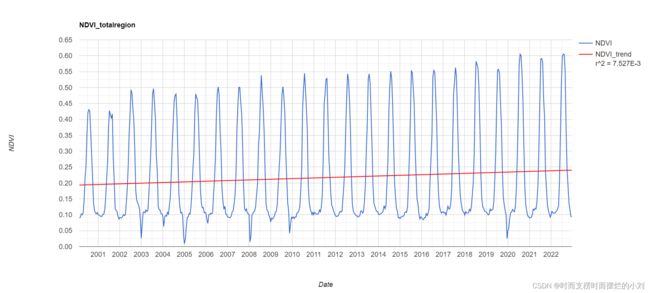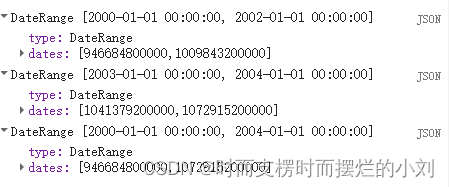GEE学习——绘制NDVI长时序曲线图
绘制全区域NDVI变化曲线——一景一值
首先认真阅读数据集介绍,包括波段名、缩放因子、数据集持续时间、空间分辨率等。
准备好研究区域、处理好数据集(缩放),先print一下看看数据集是否处理完毕。这里选的数据集MOD13Q1是500m空间分辨率、16天时间分辨率的,也可以选用其他NDVI数据集(貌似不同数据集得出的结果差异还蛮大)。
//load roi
var table = ee.FeatureCollection("projects/ee-lzying1999/assets/Boundary-wgs");
Map.centerObject(table, 9);
Map.addLayer(ee.Image().paint(table, 0, 2), {}, 'roi');
//load imagecollection 类似的NDVI数据集还有MODIS/MOD09GA_006_NDVI;MODIS/061/MOD13Q1;MODIS/006/MOD13A1
var collection = ee.ImageCollection('MODIS/006/MOD13Q1')
.filterDate('2000-01-01', '2022-12-31').filterBounds(table)
.select('NDVI').map(function(image){
return image.multiply(0.0001).set(image.toDictionary(image.propertyNames()))
}) //这里是NDVI产品的缩放因子,在数据集介绍里面有
print(collection);
对一整个区域的NDVI均值绘制长时序曲线(之前找了很久函数,捣鼓了半天list\dictionary等的数据转换,结果发现一个函数就能解决= =):
//绘制由全区域每景图像NDVI平均值构成的曲线图
print(ui.Chart.image.series({
imageCollection: collection,
region: table,
reducer: ee.Reducer.mean(),
scale: 500
}).setOptions({
interpolateNulls: true,
lineWidth: 2,
title: 'NDVI_totalregion',
vAxis: {title: 'NDVI'}, //viewWindow: {min: 0, max: 0.3}调整坐标轴上下限
hAxis: {title: 'Date'},
trendlines: { 0: {title: 'NDVI_trend',type:'linear', showR2: true, color:'red', visibleInLegend: true}} //添加趋势线
}));绘制全区域逐月平均的NDVI曲线——一月一值
关于月平均,实际上是在多个教程基础上修改了一点点绘图选项。最开始时间选择了2001-2022,结果又溢出了,所以换成了2001-2011年,这次可以显示了。
//date range
var years = ee.List.sequence(2001, 2011);
var months = ee.List.sequence(1, 12);
//monthly mean
var monthlymean = ee.ImageCollection.fromImages(
years.map(function (y) {
return months.map(function(m) {
return collection.filter(ee.Filter.calendarRange(y,y, 'year')).filter(ee.Filter.calendarRange(m, m, 'month')).mean().set('year', y).set('month', m).set('system:time_start', ee.Date.fromYMD(y, m, 1));
}); }).flatten());
print(monthlymean);
// Create and print charts.
print(ui.Chart.image.series({
imageCollection:monthlymean,
region:table,
reducer:ee.Reducer.mean(),
scale:500}).setOptions({
interpolateNulls: true,
lineWidth: 2,
title: 'NDVI Monthly Series',
vAxis: {title: 'NDVI'},
hAxis: {title: 'Date'},
//trendlines: { 0: {title: 'NDVI_trend',type:'linear', showR2: true, color:'red', visibleInLegend: true}}
}));绘制全区域逐年平均的NDVI曲线——一年一值
按年平均也有很多教程给代码,然而我到现在还是没看明白是怎么实现的QAQ,只是能用。先贴在这,找个时间恶补一下。。。
//create year list
var years = ee.List.sequence(2000, 2022);
var collectYear = ee.ImageCollection(years
.map(function(y) {
var start = ee.Date.fromYMD(y, 1, 1);
var end = start.advance(12, 'month');
return collection.filterDate(start, end).reduce(ee.Reducer.mean()).float().set('system:time_start',y).set('year',y);
}));
print(collectYear);
//create chart of NDVI_mean yearly of the total region
var Yearly_chart = ui.Chart.image.series({
imageCollection: collectYear.select('NDVI_mean'),
region: table,
reducer: ee.Reducer.mean(),
scale: 500,
xProperty: 'year',
}).setOptions({
interpolateNulls: true,
lineWidth: 2,
title: 'NDVI Yearly Series_totalregion',
vAxis: {title: 'NDVI'},//,viewWindow: {min: 0, max: 0.3}
hAxis: {title: 'Date'},
trendlines: { 0: {title: 'NDVI_trend',type:'linear', showR2: true, color:'red', visibleInLegend: true}}
});
print(Yearly_chart);将roi中的subregion取出来进行NDVI的分析
这个故事有点曲折,概括来讲就是:从ui.Chart.image.seriesByRegion到单独将灌域提取出来再手动聚合再回归ui.Chart.image.seriesByRegion。以下是我研究区的矢量文件,已经包含了各个子区域。
首先是昨天用for循环将灌域一个个提取出来的过程:
//aggregate_array这个函数将featurecollection里面的Name1提取出来成为一个list
var point = table.aggregate_array('Name1')
print(point)
//根据Name1构成的point(list)逐个提取feature(用filterMetadata方法)
for(var i = 0; i<6 ; i++){
var roi = table.filterMetadata('Name1','equals',point.get(i));
//这里就是绘制NDVI的函数,同上。在生成chart的时候将i放入图标名称中方便标识
}搞出来之后虽然觉得麻烦,但也算是节省了一部分步骤了,于是今天一整天手动处理了68个csv,把它们拼起来。现在想想真是血泪史。
事情的转机就发生在酝酿这篇“巨作”的时候。。我突然想再尝试一下ui.Chart.image.seriesByRegion这个函数,然后又上网搜教程。。上次我疑惑的点在于这个函数里面有个seriesProperty,而我的featurecollection里面没有property这个内容,放了其他的字段也总是跳错,或者直接生成整个大区域的平均值。然而,就在刚才,我把seriesProperty设置为了‘NAME’,就发现可以按照子区域绘图了。。。我晒干了沉默。。。之前设置了‘Feature Index’,没什么效果,然后发现可能是因为这个参数类型必须是string。
var chart =
ui.Chart.image
.seriesByRegion({
imageCollection: collection,
band:'NDVI',
regions: table,
reducer: ee.Reducer.mean(),
scale: 500,
seriesProperty: 'NAME', //你害得世兰好苦啊
xProperty: 'system:time_start'
})
.setOptions({
title: 'Average NDVI Value by roi',
hAxis: {title: 'Date', titleTextStyle: {italic: false, bold: true}},
vAxis: {
title: 'NDVI',
titleTextStyle: {italic: false, bold: true}
},
lineWidth: 2,
series: { //这里前面的名字和seriesProperty里面的要对应上
'Yongji': {color: 'FF0000'},
'Yichang': {color: '00FF00'},
'Wulate': {color: '0000FF'} ,
'Jiefangzha': {color: 'f0af07'},
'Wulanbuhe': {color: '0f8755'},
'Wuliangsu Lake': {color: '76b349'}
}});
print(chart);后记
本来只是想把长时序绘图的代码备一份,理一下思路,没想到还有意外收获。类似的LST、SM、GPP、NPP等绘图也是一样的,只要更改数据集、时间、波段名、绘图设置,就可以按照自己的需要绘制长时序曲线图了!另外,在应用ERA5L数据集时,时间序列太长,所以daily的数据就要分开几部分进行。2022-6-10不知道出了什么问题,没有数据总会报错,就手动跳过了这一天,尝试了union函数连接没有交集的两个时间范围,结果发现时间变得连续了。似乎只能手动剔除掉这一天了。。
var Range1 = ee.DateRange('2000-01-01','2002-01-01')
var Range2 = ee.DateRange('2003-01-01','2004-01-01')
var Range3 = Range1.union(Range2)
print(Range1,Range2,Range3)
(更:发现ui.Chart.image.seriesByRegion这个函数在数据量过大的时候经常溢出,这时候用前面for循环的办法分别导出反而省事一些,amazing)





